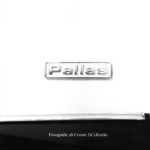
“Pallas”
testo in catalogo di Charles-Henri Favrod
“La bellezza della forma” ![]()
Nel 1955 Citroën abbandona la trazione anteriore, lanciata nel 1933, e crea un’automobile rivoluzionaria, la DS a sospensione idropneumatica, a cui faranno seguito la ID, modello molto più comune, e la Pallas, modello di lusso.
Pallas è anche uno dei tanti soprannomi della dea Atena. Ma secondo una leggenda successiva è anche il nome di una delle figlie di Tritone, amica di gioventù di Atena, uccisa accidentalmente durante uno dei loro giochi. Per renderle onore e per conservarne la memoria, Atena avrebbe aggiunto il suo nome al proprio e plasmato il Palladio, una statua a cui si attribuiscono proprietà magiche. La mitologia ci offre ancora un’altra variante: Pallas sarebbe uno dei Giganti, egli stesso padre di Atena che avrebbe voluto fare violenza alla propria figlia e che ella ucciderà e scorticherà per fare della pelle di lui la sua leggendaria corazza.
Ma il nostro scopo non è quello di parlare dell’Olimpo bensì quello di presentare il lavoro fotografico di Cesare di Liborio, che ha immortalato la bellezza delle forme dell’automobile omonima. Quest’ultima possiede una modernità incredibile, un’eleganza delle linee ed una perfezione di comfort ineguagliabili. Tutti coloro che l’hanno provata, prima di un abbandono definitivo e sempre prematuro, sono d’accordo al riguardo: mai più è stato creato di meglio.
Rimane solo la nostalgia. Rimangono i volumi e qualche esemplare del veicolo a celebrazione della sua eccellenza, che Cesare di Liborio riesce a rendere molto bene. Ma egli ha avuto l’idea di separare gli elementi e di inserirli in luoghi dove essi possono ancora esercitare appieno il loro potere di seduzione. Perché la Pallas richiama sensazioni di bellezza e di sottile erotismo, estremamente intrigante, a volte funzionale a volte “voluttuosa”, e mantiene la propria identità attraverso gli anni che avrebbero invece dovuto renderla fuori moda. Una sensazione di “scompiglio interiore” (turbamento) nata esattamente da questo fenomeno in un mondo la cui caratteristica è quella di fare precipitare tutto nel vortice del passato, e sempre più velocemente.
Cesare Di Liborio ha compreso perfettamente questo permanere, che egli ha associato alla scultura, al volume, alla forma. Nel linguaggio corrente, la forma determina lo stato nel quale noi percepiamo la materia di un determinato oggetto, e che risulta dalla costruzione e dalla disposizione delle parti. È qualcosa di concreto e palpabile. La figura assume un significato più astratto che meglio si conviene alle cose visibili, è la forma superficiale delle cose. Lo scultore crea delle forme, il pittore rappresenta delle figure, il fotografo riunisce forme e figure.
Ma Cesare Di Liborio non dimentica l’uomo nel suo inventario meticoloso e superbo della Pallas. Egli ricorda che all’origine c’è il lavoro creativo di un designer nella carrozzeria e quello tecnico-ingegneristico nelle parti meccaniche. È così che il suo lavoro si tramuta in un elogio della configurazione e della conformazione, vale a dire l’esempio per eccellenza della bellezza industriale, l’automobile che fu, a giusta ragione, chiamata Pallas.
Charles-Henri Favrod
“The beauty of shape” 
In 1955 Citroën abandoned Traction Avant, launched in 1933, and created the revolutionary DS automobile with hydropneumatic suspension. ID followed soon after, a far more popular model, and then the deluxe Pallas version.
Pallas is also one of the many nicknames for the goddess Athena but according to a later legend, it is also the name of one of Triton’s daughters, Athena’s girlhood friend, accidentally killed while they were playing. To pay her homage and to keep her memory alive it appears that Athena added her friend’s name to her own and moulded the Palladium, a statue that is said to have magical properties. Mythology offers yet another variation: Pallas was one of the Giants, he himself father of Athena who wanted to rape his own daughter but she killed and skinned him and used his skin to make the legendary cuirass.
But our purpose is not to talk about Olympus but to present Cesare Di Liborio’s photographic work that has immortalised the beautiful shapes of the car that bears the same name. This car is astoundingly modern with incomparably elegant lines and perfection in comfort. Everyone who has ever tried it agrees, before they finally, and all too soon, have to let it go, that nothing better has ever been created.
All that is left is a feeling of nostalgia. Volumes and a few specimens of the vehicle remain as homage to its excellency that Cesare Di Liborio manages to render so very well. But he had the idea of separating the elements and fit them in where they can still exert their power of seduction to the full. Since Pallas provokes sensations of beauty and subtle eroticism, highly intriguing, at times functional at times “sensual”, it maintains its identity down the years which would normally have rendered it obsolete. A feeling of “interior disturbance” (perturbation) resulting precisely from this phenomenon in a world where everything is normally hurled into the whirlpool of the past and at a constantly quickening pace.
Cesare Di Liborio perfectly understood this permanency which he associated to the sculpture, to the volume, to the shape. In everyday language the shape determines the state in which we perceive the substance of a certain object and which comes from the construction and arrangement of the parts. It is something solid and palpable. The figure assumes a more abstract meaning which is preferable for visible things, it is the superficial shape of things. The sculpture creates the shapes, the artist paints the figures, the photographer combines shapes and figures.
But Cesare Di Liborio does not forget man in his meticulous and superb account of Pallas. He remembers that the creative work of a designer for the bodywork and the work of an engineer for the mechanical parts are at the roots. And this is how his work transforms into appreciation for configuration and shape which goes to say the example par excellence of industrial beauty, the automobile that was quite rightly called Pallas.
Charles-Henri Favrod